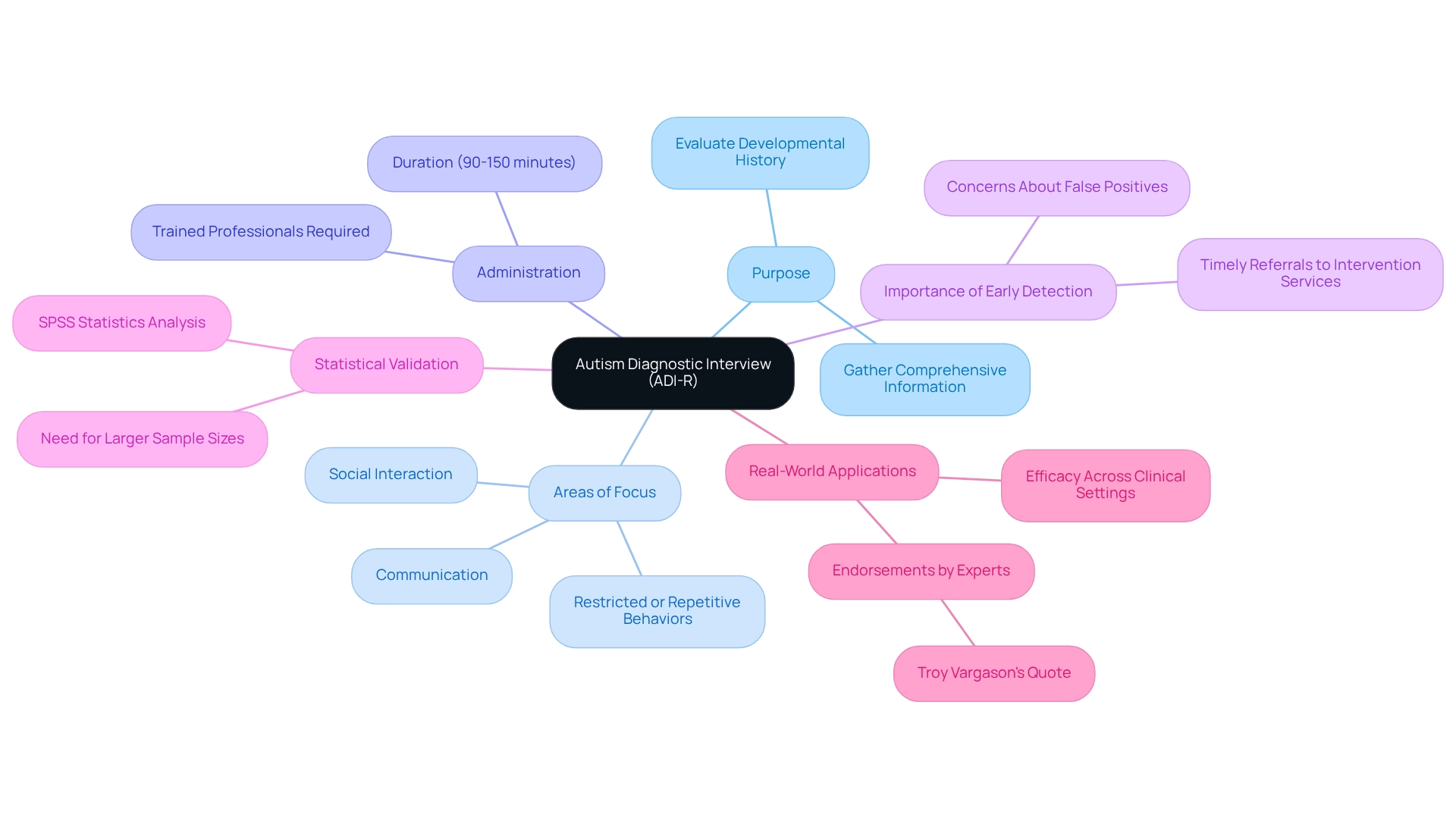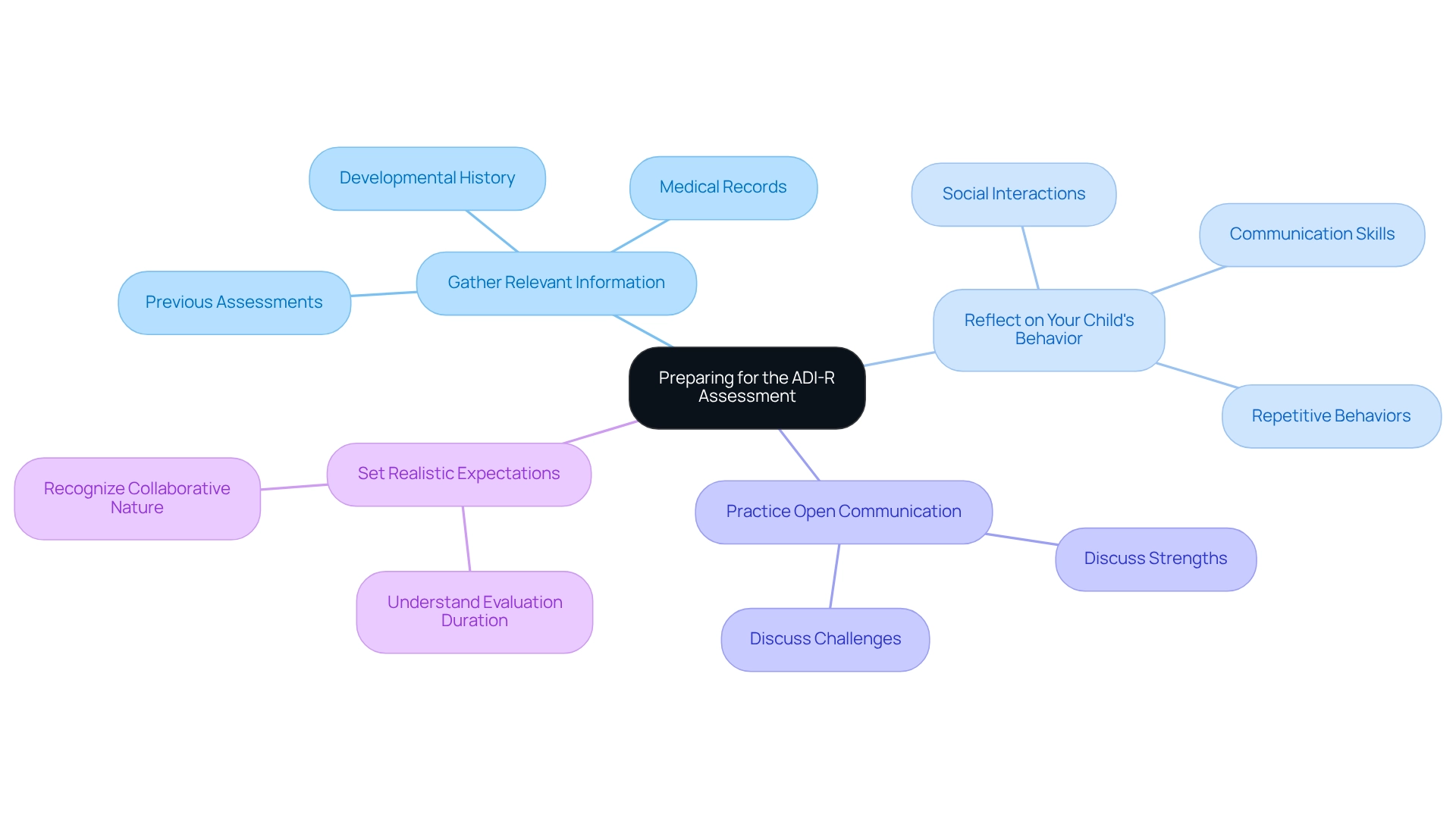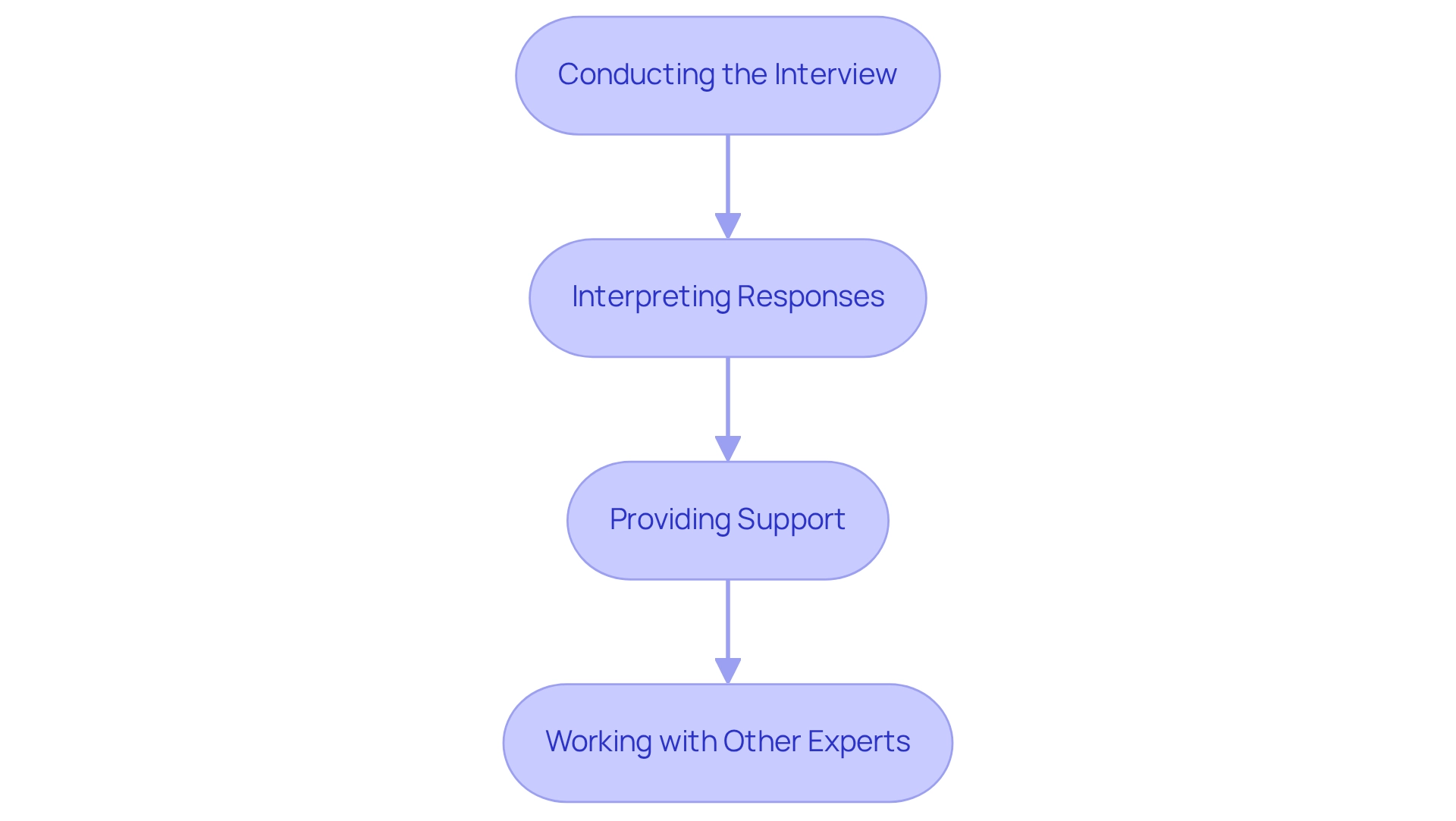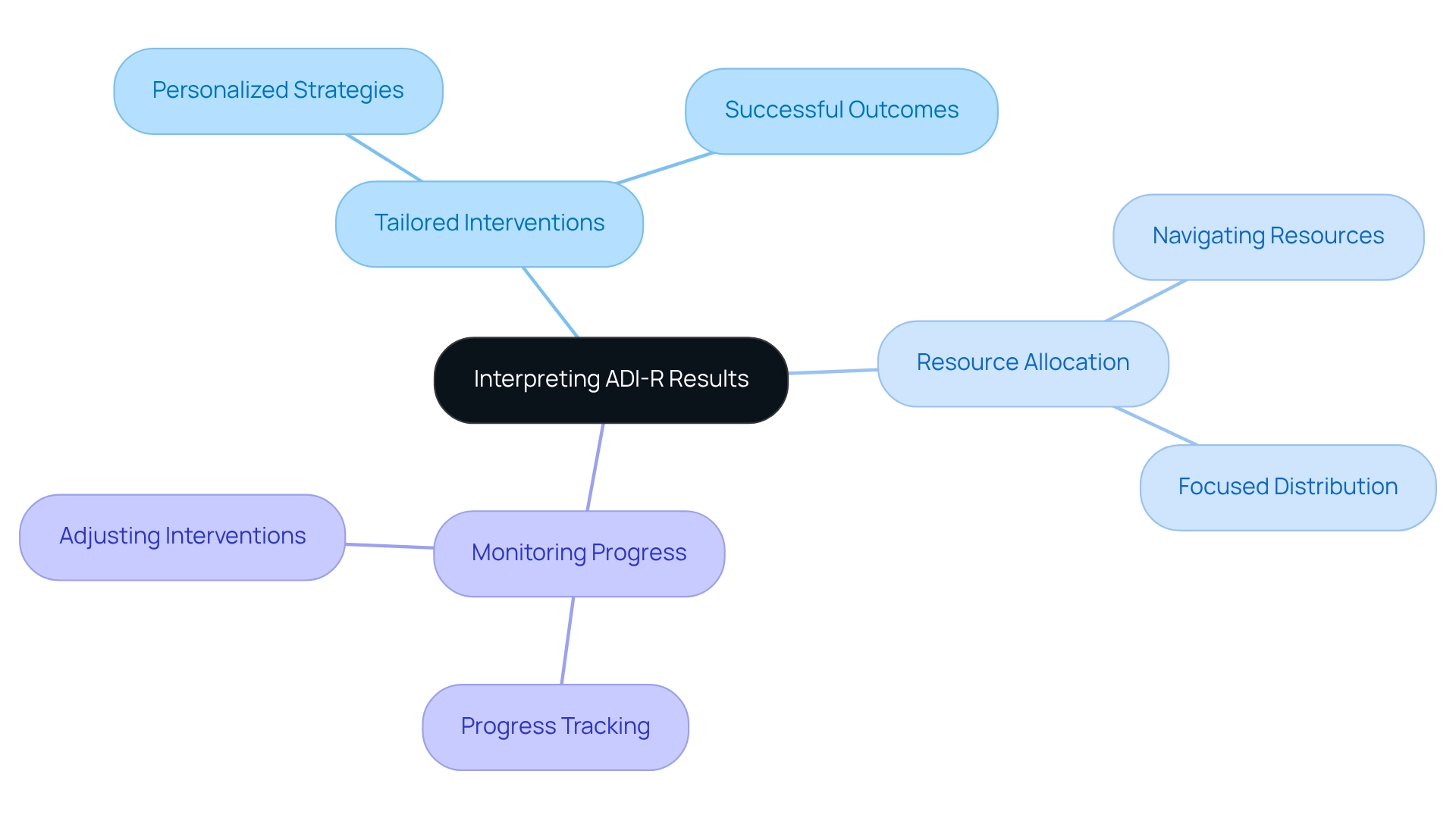Overview
This article highlights the Autism Diagnostic Interview PDF (ADI-R), a structured tool designed to assess autism spectrum disorder (ASD) in individuals. It serves as a vital resource for both parents and professionals, guiding them through the complexities of diagnosis.
The ADI-R is recognized for its reliability and validity, offering a comprehensive evaluation of essential areas such as:
- Social interaction
- Communication
- Repetitive behaviors
However, it is crucial to approach the administration and interpretation of this tool with care, ensuring that trained professionals are involved to achieve accurate outcomes and provide effective support.
As we navigate this journey together, it’s important to remember that support is available, and understanding is key. We encourage you to share your experiences and seek out resources that can help you and your loved ones.
Introduction
In the intricate landscape of autism diagnosis, the Autism Diagnostic Interview-Revised (ADI-R) emerges as a vital tool, offering invaluable insights into an individual's developmental history and behaviors. This structured interview, primarily conducted with parents and caregivers, explores essential areas such as social interaction, communication, and repetitive behaviors. By providing a comprehensive framework for assessing autism spectrum disorder (ASD), the ADI-R becomes an essential resource for families.
As the demand for early and accurate diagnoses continues to grow, understanding the nuances of the ADI-R is increasingly critical. It requires meticulous preparation for the assessment, followed by the interpretation of results that guide tailored interventions. The ADI-R is not merely a diagnostic tool; it serves as a lifeline for families seeking clarity and support while navigating the complexities of autism. Together, we can foster a deeper understanding and create a supportive environment for those affected.
Overview of the Autism Diagnostic Interview (ADI-R)
The autism diagnostic interview PDF is a vital structured interview tool designed to gather comprehensive information about an individual's developmental history and current behaviors. This resource is primarily provided to parents or guardians of those suspected of having spectrum conditions, focusing on three crucial areas: social interaction, communication, and restricted or repetitive behaviors. Valued for its strong reliability and validity, this assessment is essential in evaluating both youth and adults with autism.
Typically lasting between 90 to 150 minutes, this assessment requires trained professionals to ensure accurate administration and interpretation. Recent discussions in the field highlight the importance of early detection; timely referrals to intervention services can significantly enhance outcomes for young children. However, concerns regarding potential false positives in early diagnoses underscore the need for careful evaluation and a thorough understanding of the diagnostic process.
Statistical analyses performed with SPSS Statistics have demonstrated the effectiveness of this assessment in distinguishing between ASD and other developmental disorders. Yet, limitations in current studies call for further research to confirm these diagnostic tools. For instance, a recent study titled "Limitations in ASD Diagnostic Studies" emphasized the need for larger sample sizes to accurately represent the severity and functioning levels associated with ASD, reinforcing the significance of this assessment tool in clinical environments. Additionally, the Karger Article Bundle Token, priced at $150, indicates potential resource investments for parents and professionals seeking comprehensive information.
Expert assessments consistently validate the autism diagnostic interview PDF as a gold-standard instrument in diagnosing developmental disorders. As Troy Vargason noted, 'The Autism Diagnostic Interview PDF and Autism Diagnostic Observation Schedule are two gold-standard tools used to assist with the diagnosis of ASD.' This endorsement highlights the assessment tool's importance in diagnosing individuals on the spectrum.
Real-world applications of this assessment tool have illustrated its efficacy across diverse clinical settings, further affirming its role as a crucial resource for professionals and families navigating the complexities of developmental disorder diagnoses. If you have experiences or questions about the diagnostic process, we encourage you to share them in the comments or through our newsletters, fostering a supportive community for all.

Criteria and Tools Utilized in the ADI-R Assessment
Understanding the evaluation of the Autism Diagnostic Interview PDF is essential for parents who want the best for their children. This structured interview is grounded in the DSM-5 guidelines for diagnosing Autism Spectrum Disorder (ASD) and focuses on several critical domains that can impact a child's development.
- Social Interaction is one of the key areas assessed. This domain evaluates how well your child engages socially, looking at their ability to connect with others in different situations.
- Equally important is the Communication domain, where both verbal and non-verbal skills are examined. This provides valuable insights into how your child expresses themselves and understands those around them.
- Another significant area is Repetitive Behaviors, which identifies patterns that may be restricted or repetitive—often characteristic of autism. These core criteria are complemented by standardized scoring algorithms that categorize responses, enabling clinicians to effectively determine the presence and severity of autism symptoms.
Moreover, the incorporation of tools like the Autism Diagnostic Observation Schedule (ADOS) enhances the evaluation's thoroughness. This instrument allows for direct observation of your child's behavior, which complements the parental reports gathered through the ADI-R, ensuring a comprehensive understanding of their developmental profile.
Recent findings from the Study to Explore Early Development (SEED) highlight the value of the DSM-5 definition of ASD, achieving diagnostic sensitivity of 0.95 and specificity of 0.78 in preschoolers. This underscores the importance of adhering to these updated guidelines. It's noteworthy that only 30 individuals in the SEED2 sample did not exhibit cognitive or language delays, which speaks to the diverse manifestations of autism and the necessity for tailored evaluations.
The criteria in the Autism Diagnostic Interview PDF align closely with the DSM-5 guidelines, which have been refined to clarify the intent behind diagnosing the disorder. The American Psychiatric Association (APA) emphasizes that the 2022 DSM-5-TR revision has improved the diagnostic criteria, enhancing evaluation accuracy. As our understanding of autism continues to evolve, ongoing research and case studies—such as those comparing DSM-IV-TR and DSM-5 definitions—will shed light on the developmental profiles of children with milder symptoms. This ensures that evaluations remain relevant and effective in identifying ASD, providing the support that families need.
If you have any experiences or thoughts about these evaluations, we encourage you to share them. Your stories can help others feel less alone in this journey.
Understanding Diagnostic Criteria for Autism Spectrum Disorder
Understanding Autism Spectrum Disorder (ASD) can feel overwhelming, especially for parents seeking clarity and support. The diagnostic criteria for ASD, outlined in the DSM-5, highlight persistent challenges in social communication and interaction across various contexts, along with restricted and repetitive behaviors. These criteria fall into two main categories:
- Social Communication Deficits: Here, significant challenges arise in social-emotional reciprocity—essentially, the ability to engage in meaningful back-and-forth interactions. This domain also encompasses difficulties in nonverbal communication, such as maintaining eye contact or using gestures. Parents may notice their child struggles to develop and maintain relationships, adapting their behavior in different social situations, or sharing imaginative play with peers.
- Restricted and Repetitive Behaviors: This category includes stereotyped movements, like hand-flapping or rocking, and a strong insistence on sameness, which can manifest as distress in response to minor changes in routines or environments. Additionally, children may display intense interests, focusing deeply on specific subjects or activities.
Grasping these criteria is crucial for analyzing outcomes from the Autism Diagnostic Interview PDF. They provide a fundamental framework for recognizing neurodevelopmental disorders and distinguishing them from other developmental conditions. Recent studies reveal that limited and repetitive behaviors in youth with autism remain significant, underscoring the need for precise evaluations that align with the latest DSM-5 updates. According to the Autism CARES Act of 2014, ongoing research is vital to enhance coordination among NIH components funding ASD research, highlighting the importance of continuous study in this area.
Moreover, findings from the ADDM Network 2020 surveillance year, as highlighted by Matthew J. Maenner, indicate a higher prevalence of ASD than previously estimated, along with a notable shift in the demographic composition of children diagnosed with this condition. This emphasizes the necessity for accurate evaluations. A multicenter study on Vasopressin has shown potential improvements in social communication among adults with ASD, suggesting promising avenues for enhancing social skills.
Additionally, a recent study from Hebrew University explored how the brain processes speech patterns into dialogues, shedding light on contemporary research trends related to social communication challenges in autism evaluations. As the field evolves, expert insights continue to illuminate the nuances of these diagnostic criteria, ensuring evaluations are comprehensive and reflective of the latest research developments. If you have experiences or questions regarding these challenges, we encourage you to share them in the comments or through our newsletter, fostering a supportive community for all navigating this journey.
Preparing for the ADI-R Assessment: Tips and Expectations
Preparing for the autism diagnostic interview PDF evaluation is a crucial step in understanding your child's unique needs. Here are some key strategies to help ensure a successful experience:
- Gather Relevant Information: Start by compiling your child's developmental history, medical records, and any previous assessments. This thorough background will be invaluable during the autism diagnostic interview PDF, allowing the clinician to gain a complete picture of your child's development.
- Reflect on Your Child's Behavior: Take time to consider specific instances that illustrate your child's social interactions, communication skills, and any repetitive behaviors. Documenting these examples can provide vital insights that guide the evaluation process.
- Practice Open Communication: Approach the assessment with a mindset of transparency. Be prepared to discuss both your child's strengths and challenges openly. This honesty will help the clinician tailor their approach and better understand your child's unique profile.
- Set Realistic Expectations: Understand that the evaluation process may take time and is inherently collaborative. Recognizing that the objective is to collect the most accurate information possible can help alleviate any anxiety related to the evaluation.
Research indicates that parental preparation significantly influences the effectiveness of the autism diagnostic interview PDF during evaluations. A cohort study identified common parental concerns prior to an ASD diagnosis, highlighting worrisome behaviors and feelings about the diagnosis, which underscores the importance of thorough preparation. Furthermore, statistics from Tonge and colleagues (2014) show that the PEBM group performed better than PEAC on the VABS daily living domain, illustrating the positive impact of effective parent training on assessment outcomes.
As Karen Bearss, PhD, pointed out, "This study examined the efficacy of parent training versus parent education in youths with ASD and moderate or greater behavioral issues," highlighting the essential role of preparation and training for parents.
Moreover, a case study on the Primary Care Stepping Stones Triple P program demonstrated that effective parent training can lead to significant improvements in parenting practices and youth behavior outcomes over time. This underscores the importance of parent training in preparing for the evaluation.
By following these suggestions, parents can contribute to a comprehensive and efficient evaluation, ultimately creating opportunities for improved support and resources for their children. Future research should aim to standardize definitions and features of parent training interventions, facilitating more informative meta-analyses and enhancing clinical effectiveness.

Personal Experiences: Navigating the ADI-R Assessment
Many parents experience significant anxiety leading up to the autism diagnostic interview pdf evaluation, often preoccupied with worries about their child's performance. Sharing personal experiences can be instrumental in easing these concerns. For example, one parent found that reflecting on their child's early developmental milestones enabled them to provide detailed and accurate information during the autism diagnostic interview pdf.
Another parent highlighted the importance of honesty regarding their child's behaviors, noting that this transparency resulted in a more tailored support plan following the autism diagnostic interview pdf assessment. These stories underscore the vital role of preparation and collaboration in this journey, reinforcing that parents are not alone, especially when navigating the autism diagnostic interview pdf.
To further assist parents, several strategies can be beneficial. For instance, using video recordings of behaviors can help parents recall specific details more accurately, while creating comprehensive timelines of their child's developmental milestones can facilitate the provision of extensive information during the evaluation. Research shows that personal narratives can significantly reduce anxiety, indicating that open conversations among parents, particularly in the context of the autism diagnostic interview pdf, can nurture a supportive community. By sharing their experiences and strategies, parents can approach the assessment process with increased confidence and clarity.
As Andrew Pickles noted, the involvement of families is crucial, highlighting the importance of teamwork throughout the evaluation process.
The Role of Professionals in the ADI-R Process
Professionals play a crucial role in the autism diagnostic interview process, ensuring that assessments are conducted with both effectiveness and ethical integrity. Their key responsibilities encompass several critical areas that directly impact families seeking answers:
- Conducting the Interview: Skilled clinicians lead the interview process with care, employing a structured format to ask targeted questions that elicit comprehensive responses from parents. This method is essential for gathering nuanced information about the child's behavior and development, which can be a source of concern for many families.
- Interpreting Responses: After collecting data, professionals meticulously analyze the responses to identify patterns and behaviors that may indicate autism spectrum disorder (ASD). This interpretative stage is vital for establishing an accurate diagnosis, especially considering that ASD affects 1-3% of children worldwide. It underscores the necessity for thorough evaluations, such as the autism diagnostic interview.
- Providing Support: Throughout the evaluation, professionals offer continuous assistance to families, addressing concerns and questions that may arise. This compassionate guidance helps alleviate anxiety and fosters a collaborative environment, making the process less daunting for parents.
- Working with Other Experts: The autism diagnostic interview is often part of a broader evaluation approach that may include supplementary instruments like the Autism Diagnostic Observation Schedule (ADOS). This collaboration among various specialists ensures a comprehensive evaluation, leading to the most accurate diagnosis and tailored recommendations for support.
The role of experts in the autism diagnostic interview process extends beyond mere evaluations; it involves fostering a supportive environment for families facing the challenges of diagnosis. As highlighted in the case study titled "Role of Parental Occupation in Autism Spectrum Disorder Diagnosis and Severity," the complexities of ASD can significantly influence diagnosis and severity. This reality underscores the importance of professionals' responsibilities. Their training and expertise, as emphasized by Eilidh Cage, are essential in ensuring that evaluations are comprehensive and responsive to the unique needs of each child and family.
Moreover, it is important to recognize that assessments for developmental disorders typically occur in a single session, although some evaluations may require multiple sessions. Professionals must manage these effectively to provide the best support. Additionally, the range of knowledge and attitudes towards autism among healthcare professionals can vary, impacting the quality of assessments and the support provided to families.
If you find yourself navigating this journey, remember that you are not alone. Reach out to professionals who can guide you and share your experiences with others who understand.

Interpreting ADI-R Results: Implications for Treatment and Support
Interpreting the results of the autism diagnostic interview PDF is a vital step in the diagnostic process. These outcomes can significantly influence treatment plans and support services, making it essential to understand their implications.
- Tailored Interventions: The findings pinpoint specific areas where a young person may need additional support, allowing for the creation of personalized intervention strategies. This customized approach is crucial, as research indicates that strategies developed from personal evaluations lead to more successful outcomes.
- Resource Allocation: By grasping the severity and nature of a young person's challenges through assessment results, families can navigate the array of available resources and services more effectively. This focused distribution ensures that young individuals receive the most suitable assistance, enhancing their developmental journey.
- Monitoring Progress: The assessment tool serves as a significant reference point for tracking progress over time. By regularly reviewing these outcomes, families and professionals can adjust interventions as necessary, ensuring that strategies align with the individual's evolving needs.
The importance of accurately interpreting assessment results, particularly those outlined in the autism diagnostic interview PDF, cannot be overstated. It empowers parents and professionals to collaborate in fostering a nurturing environment that supports the young one's growth and development. For instance, a recent study on the interrater reliability of the assessment tool showed high consistency in diagnostic criteria across various domains, with values ranging from 0.91 to 1.00, reinforcing its utility in clinical settings.
This reliability emphasizes that knowledgeable interpretations of outcomes can lead to more efficient autism intervention strategies, ultimately benefiting the child and their family. Additionally, with 60.84% of mothers holding a Graduate or Bachelor degree, many parents involved in the process likely possess a solid understanding of the implications of these results. As Marcio Leyser from the University of Iowa highlights, 'Early diagnosis is fundamental for early intervention as it positively impacts developmental and behavioral trajectories.'
However, it is also important to recognize the limitations of research on the assessment tool, including potential biases from unbalanced sample compositions. This acknowledgment provides a fair perspective on the studies supporting its application.

Additional Resources and Support for ADI-R and Autism Diagnosis
For parents and professionals seeking comprehensive support and information regarding the Autism Diagnostic Interview-Revised (ADI-R) and diagnoses related to spectrum disorders, several key types of resources are invaluable.
- Guides and Resources on Diagnosis: Various organizations provide extensive guides and resources on diagnosis and treatment, helping families understand the complexities involved in the process.
- Screening and Diagnosis Information: Resources tailored for families ensure they have access to the latest guidelines and support regarding screening and diagnosis.
- Research and Information on Spectrum Disorders: A wealth of research and information can aid families in making informed decisions about their offspring's care.
- Materials and Training Related to the ADI-R: Specialized materials and training can enhance understanding and implementation of the diagnostic process.
These resources not only provide essential insights but also support families as they navigate the complexities of diagnosis and treatment. Recent studies indicate that individuals with autism have greater odds than their peers of receiving gastrointestinal prescriptions—2 to 3 times greater odds—and psychotropic medications—4 to 19 times greater odds. This emphasizes the need for customized healthcare models that meet the specific requirements of these young individuals.
Additionally, as families seek support, customized strategies to reduce healthcare access issues for youth with ASD at both the policy and practice levels may help encourage more optimal service utilization and health throughout the lifespan. A case study on healthcare service utilization patterns revealed that children with developmental disorders experienced a significant increase in healthcare service utilization, including higher rates of inpatient hospitalizations and emergency department visits compared to their peers. By leveraging these resources, families can better navigate the challenges associated with the autism diagnostic interview pdf and obtain the support they need.
Conclusion
The Autism Diagnostic Interview-Revised (ADI-R) stands as a vital resource for diagnosing autism spectrum disorder (ASD), concentrating on essential areas such as social interaction, communication, and repetitive behaviors. Its proven reliability and validity render it invaluable for both professionals and families embarking on the journey of autism diagnosis.
Preparing effectively for the ADI-R assessment is crucial. Parents can enhance this process by gathering relevant information and reflecting on their child's behaviors. This not only enriches the assessment but also helps to alleviate anxiety. Such collaborative efforts foster a supportive community among families, reinforcing the comforting notion that they are not alone in this journey.
Equally important is the interpretation of the ADI-R results, as these outcomes directly inform personalized treatment plans and resource allocation. By pinpointing specific areas where a child may need support, the ADI-R facilitates tailored interventions that can significantly influence developmental progress. Ongoing monitoring ensures that strategies remain aligned with the evolving needs of the child.
Ultimately, the ADI-R transcends its role as a diagnostic tool; it serves as a lifeline for families seeking clarity and guidance. By understanding its nuances and preparing thoughtfully, families and professionals can unite to create nurturing environments that promote growth and development for individuals with autism. As the field continues to evolve, leveraging available insights and resources will be vital in enhancing support for those affected by autism spectrum disorder.
Frequently Asked Questions
What is the Autism Diagnostic Interview PDF?
The Autism Diagnostic Interview PDF is a structured interview tool designed to gather comprehensive information about an individual's developmental history and current behaviors, focusing on social interaction, communication, and restricted or repetitive behaviors.
Who is the Autism Diagnostic Interview PDF primarily provided to?
It is primarily provided to parents or guardians of individuals suspected of having autism spectrum conditions.
How long does the assessment typically take?
The assessment typically lasts between 90 to 150 minutes.
Who administers the Autism Diagnostic Interview PDF?
The assessment requires trained professionals to ensure accurate administration and interpretation.
Why is early detection important in autism diagnosis?
Early detection is crucial because timely referrals to intervention services can significantly enhance outcomes for young children.
What concerns exist regarding early diagnoses of autism?
There are concerns about potential false positives in early diagnoses, which highlight the need for careful evaluation and a thorough understanding of the diagnostic process.
How effective is the Autism Diagnostic Interview PDF in distinguishing between autism spectrum disorder (ASD) and other developmental disorders?
Statistical analyses have shown that the assessment is effective in distinguishing between ASD and other developmental disorders, although limitations in current studies call for further research.
What are the key areas assessed by the Autism Diagnostic Interview PDF?
The key areas assessed include social interaction, communication (both verbal and non-verbal), and repetitive behaviors.
How does the Autism Diagnostic Interview PDF align with DSM-5 guidelines?
The Autism Diagnostic Interview PDF is grounded in the DSM-5 guidelines for diagnosing ASD and incorporates standardized scoring algorithms to categorize responses.
What additional tools are used alongside the Autism Diagnostic Interview PDF for a thorough evaluation?
The Autism Diagnostic Observation Schedule (ADOS) is used in conjunction with the Autism Diagnostic Interview PDF to provide direct observation of the child's behavior.
What recent findings support the importance of the DSM-5 definition of ASD?
Recent findings from the Study to Explore Early Development (SEED) indicate that the DSM-5 definition achieves high diagnostic sensitivity and specificity in preschoolers.
How has the DSM-5-TR revision improved diagnostic criteria for autism?
The 2022 DSM-5-TR revision has refined diagnostic criteria, enhancing evaluation accuracy and clarifying the intent behind diagnosing the disorder.




